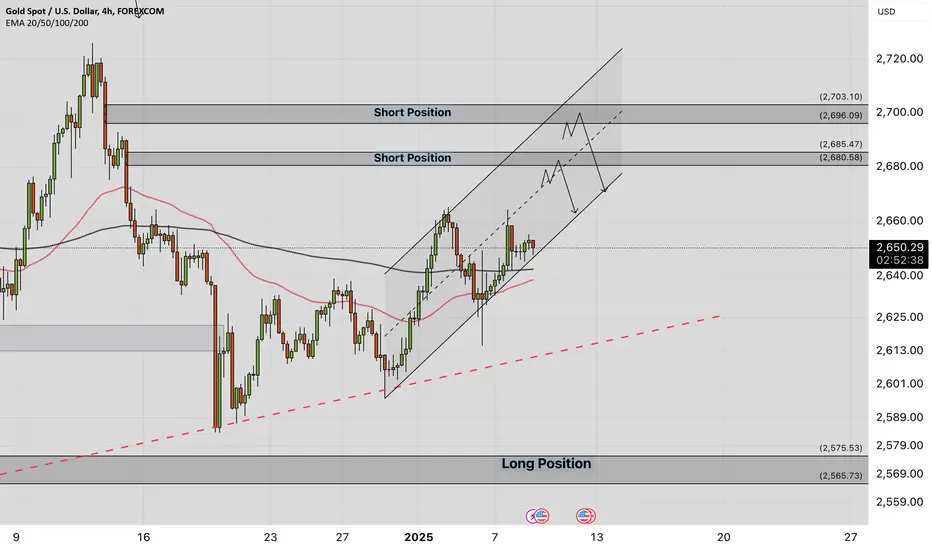Gold is above the EMA200 and EMA50 in the 4-hour timeframe and is in its ascending channel. The continued rise of gold towards the supply zones will provide a position to sell it with a suitable risk reward.
The performance of commodities in 2024 was highly diverse. While investors turned to gold as a hedge against inflation, other commodities like iron ore experienced declines due to weak economic growth in China, the world’s largest metals consumer. It seems that the story this year will resemble that of the previous year.
Sabrina Chaudhry, Head of Commodities Analysis at BMI Research, stated, “Commodities will generally face pressure in 2025,” adding that the strong US dollar will limit demand for dollar-priced commodities.
Adrian Ash, Director of Research at BullionVault, a gold investment services company, said investors are optimistic about gold and silver in 2025 due to pessimism surrounding geopolitical conditions and rising government debt, emphasizing gold’s role as a risk hedge.
Analysts at J.P. Morgan also predict that gold prices will rise, especially if U.S. policies take a more “disruptive” turn through increased tariffs, heightened trade tensions, and greater risks to economic growth.
Gold recorded its best annual performance in over a decade last year. According to FactSet data, gold bullion prices rose by approximately 26% in 2024, driven by central bank purchases as well as retail investment.
Data indicates that China purchased gold for the second consecutive month in December. The country’s gold reserves increased to 73.29 million ounces in December, up from 72.96 million ounces in November. China’s gold buying pace has nearly doubled, with December’s 0.33 million-ounce increase significantly surpassing the 0.16 million-ounce rise in November. The value of China’s gold reserves is now estimated at around $191 billion, while its total foreign exchange reserves stand at $3.2 trillion.
Meanwhile, Goldman Sachs has postponed its previous forecast of gold prices reaching $3,000 per ounce by the end of 2025 to mid-2026. This adjustment is attributed to expectations of a slower pace of interest rate cuts by the Federal Reserve.
A slower reduction in interest rates in 2025 is likely to limit demand for gold-backed Exchange-Traded Funds (ETFs). As a result, analysts such as Lina Thomas and Dan Stryon have forecasted gold prices to reach $2,910 per ounce by the end of the year. In a note, they mentioned that weaker-than-expected ETF inflows in December — attributed to reduced uncertainty following the U.S. elections — also contributed to a lower starting point for prices in the new year.
Analysts commented, “Counteracting forces — reduced speculative demand and increased central bank purchases — have effectively neutralized each other, keeping gold prices range-bound in recent months.”
They further emphasized that central bank appetite for gold purchases remains a key driver for prices in the long term. Analysts projected, “Looking ahead, we expect monthly gold purchases to average 38 tons through mid-2026.”
The performance of commodities in 2024 was highly diverse. While investors turned to gold as a hedge against inflation, other commodities like iron ore experienced declines due to weak economic growth in China, the world’s largest metals consumer. It seems that the story this year will resemble that of the previous year.
Sabrina Chaudhry, Head of Commodities Analysis at BMI Research, stated, “Commodities will generally face pressure in 2025,” adding that the strong US dollar will limit demand for dollar-priced commodities.
Adrian Ash, Director of Research at BullionVault, a gold investment services company, said investors are optimistic about gold and silver in 2025 due to pessimism surrounding geopolitical conditions and rising government debt, emphasizing gold’s role as a risk hedge.
Analysts at J.P. Morgan also predict that gold prices will rise, especially if U.S. policies take a more “disruptive” turn through increased tariffs, heightened trade tensions, and greater risks to economic growth.
Gold recorded its best annual performance in over a decade last year. According to FactSet data, gold bullion prices rose by approximately 26% in 2024, driven by central bank purchases as well as retail investment.
Data indicates that China purchased gold for the second consecutive month in December. The country’s gold reserves increased to 73.29 million ounces in December, up from 72.96 million ounces in November. China’s gold buying pace has nearly doubled, with December’s 0.33 million-ounce increase significantly surpassing the 0.16 million-ounce rise in November. The value of China’s gold reserves is now estimated at around $191 billion, while its total foreign exchange reserves stand at $3.2 trillion.
Meanwhile, Goldman Sachs has postponed its previous forecast of gold prices reaching $3,000 per ounce by the end of 2025 to mid-2026. This adjustment is attributed to expectations of a slower pace of interest rate cuts by the Federal Reserve.
A slower reduction in interest rates in 2025 is likely to limit demand for gold-backed Exchange-Traded Funds (ETFs). As a result, analysts such as Lina Thomas and Dan Stryon have forecasted gold prices to reach $2,910 per ounce by the end of the year. In a note, they mentioned that weaker-than-expected ETF inflows in December — attributed to reduced uncertainty following the U.S. elections — also contributed to a lower starting point for prices in the new year.
Analysts commented, “Counteracting forces — reduced speculative demand and increased central bank purchases — have effectively neutralized each other, keeping gold prices range-bound in recent months.”
They further emphasized that central bank appetite for gold purchases remains a key driver for prices in the long term. Analysts projected, “Looking ahead, we expect monthly gold purchases to average 38 tons through mid-2026.”
Disclaimer
The information and publications are not meant to be, and do not constitute, financial, investment, trading, or other types of advice or recommendations supplied or endorsed by TradingView. Read more in the Terms of Use.
Disclaimer
The information and publications are not meant to be, and do not constitute, financial, investment, trading, or other types of advice or recommendations supplied or endorsed by TradingView. Read more in the Terms of Use.
